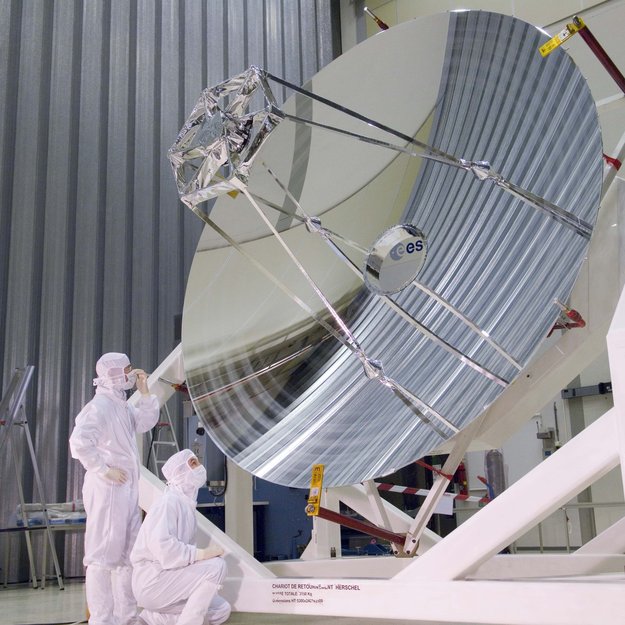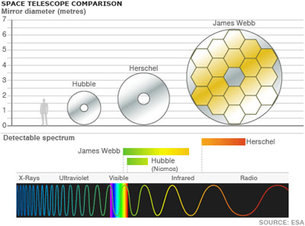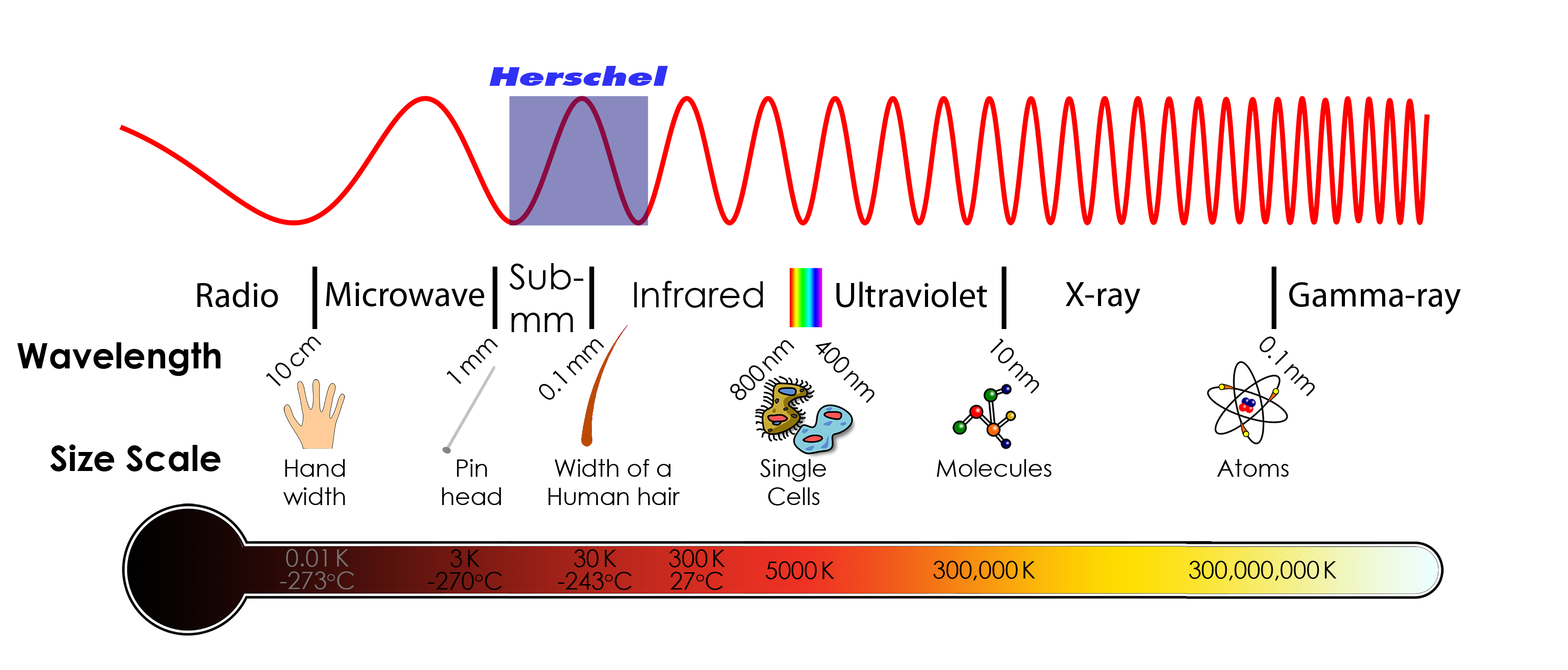Herschel Space Observatory
A work in progress:
A Brief History of the Herschels: Caroline and William Herschel: The Herschels were pioneers of the systematic classification and investigation of the heavens. William Herschel was one of the first 'professional' astronomers, and discovered infrared radiation. His sister Caroline helped him to develop the modern mathematical approach to astronomy.
William, son of a musician, was born in Hanover, Germany, in 1738. He followed in his father's footsteps, joining the Hanoverian Guard band to play the oboe, but moved to England to teach music in 1755, eventually settling in Bath in 1766.
He became interested in astronomy, and started to build his own telescopes. He developed and refined Isaac Newton‘s designs to avoid problems with poor glass optics. Herschel cast and polished his own mirrors, producing ever bigger and better telescopes.
The Herschel Space Observatory is the largest infrared space telescope ever launched. With its 3.5-m primary mirror, it is four times bigger than any previous infrared space telescope and almost one and a half times larger than the Hubble Space Telescope.
Herschel - the Space Observatory: ESA’s cutting-edge space observatory, carries the largest, most powerful infrared telescope ever flown in space. A pioneering mission, it is studying the origin and evolution of stars and galaxies to help understand how the Universe came to be the way it is today.
The first observatory to cover the entire range from far-infrared to submillimetre wavelengths and bridge the two, Herschel is exploring further into the far-infrared than any previous mission, studying otherwise invisible dusty and cold regions of the cosmos, both near and far. Including the area called NGC281, or the Pacman Nebula, this is the area that SHIPs is researching for their project during 2013.
By tapping these unexploited wavelengths, Herschel is seeing phenomena beyond the reach of other observatories, and studying others at a level of detail that has not been captured before. The telescope’s primary mirror is 3.5 m in diameter, more than four times larger than any previous infrared space telescope and almost one and a half times larger than that of the Hubble Space Telescope. Its size is allowing Herschel to collect almost 20 times more light than any previous infrared space telescope.
The spacecraft carries three advanced science instruments: two cameras and a very high-resolution spectrometer. The detectors in these instruments are cooled to temperatures close to absolute zero by a sophisticated cryogenic system.
Launch: 14 May 2009 on an Ariane 5 from ESA’s Spaceport in Kourou, French Guiana. The launch took place at 13:12:02 GMT. Herschel was launched along with Planck, ESA’s microwave observatory, which is studying the Cosmic Microwave Background. (See other NITARP Projects using Planck)
Herschel's primary mirror is the telescope's light collector. It captures the light from astronomical objects and directs it towards the smaller secondary mirror. The two mirrors work together focusing the light and directing it to the instruments, where the light is detected and analysed, and the results recorded by the onboard computer.
The size of the primary mirror is the key to any telescope's sensitivity: the bigger it is, the more light it collects, and the fainter the objects it sees. It also determines the telescope's ability to distinguish fine details. The surface of the mirror is very important, too. It has to be precisely shaped and perfectly smooth, since the slightest roughness distorts the final image.
A mirror must be light and sturdy to withstand the extreme conditions of launch (where it was shaken with a force several times that of Earth’s gravity), and the low temperatures of outer space; and any bump on its surface must be less than a thousandth of a millimetre high.
This technological marvel has been constructed almost entirely of silicon carbide. The primary mirror has been made out of 12 segments brazed together to form a monolithic mirror which was machined and polished to the required thickness (about 3 mm), shape, and surface accuracy.
Vital Stats: The Herschel satellite is a tall cylinder, about 7.5 m high and 4.0 m wide, with a launch mass of around 3.4 tonnes.
| Dimensions | ~ 7.5 x 4.0 m (height x width) |
| Mass | 3.4 tonnes at launch |
| Telescope mass | 315 kg |
| Spacecraft | 3-axis stabilised |
| Telescope size | 3.5 m diameter primary mirror |
| Science data rate | 130 kbps |
| Lifetime | 3.5 years |
| Operational orbit | Lissajous orbit at an average distance of 800 000 km from L2 |
| Attitude thrusters | 12 thrusters, 20 N each |
| Solar arrays | Flat, fixed panels of triple-junction,Ga As cells, |
| Solar array area: | about 12 m2 |
| Batteries | 39 Ah Lithium ion batteries |
| Communication | 2 low gain antennae,1 medium gain antenna |
Herschel Space Telescope Science Objectives:
Herschel is set to revolutionize our understanding of the Universe. A versatile infrared space telescope, Herschel's main objective is to study relatively cool objects across the Universe: in particular the formation and evolution of stars and galaxies, and the relationship between the two.
Within our Galaxy, the mission’s main science objectives are:
To study Solar System objects such as asteroids, Kuiper belt objects, and comets. Comets are the best-preserved fossils of the early Solar System, and hold clues to the raw ingredients that formed the planets, including Earth.
To study the process of star and planet formation. Herschel is unique in its coverage of a wide range of infrared wavelengths, with which it is looking into star-forming regions in our Galaxy, to reveal for the first time different stages of early star formation and the youngest stars. The telescope is also studying circumstellar material around young stars, where astronomers believe that planets are being formed, and debris discs around more mature stars.
To study the vast reservoirs of dust and gas in our Galaxy and in other nearby galaxies. Herschel is studying in detail the physics and kinematics at work in giant clouds of gas and dust that give rise to new stars and associated planetary bodies. Herschel is also well suited to studying astrochemistry providing fundamental new insights into the complex chemistry of these molecular clouds, the wombs of future stars.
Outside our Galaxy, the mission’s main science objectives are:
To explore the influence the galactic environment has on interstellar medium physics and star formation. Most of what we have learned about the physics and chemistry of the interstellar medium, and about the processes there such as star formation has been gained by studies in our own Galaxy. With Herschel, we can carry out similar studies in relatively nearby galaxies as well. For example, studies of nearby low-metallicity galaxies can open the door to the understanding of these processes in the early Universe.
To chart the rate of star formation over cosmic time. We know that star and galaxy formation commenced relatively early after the Big Bang. We also know that when the Universe was about half its current age, star formation was much more intense than it is today. Herschel is ideal for studying infrared-dominated galaxies at the peak of star formation.
To resolve the infrared cosmic background and characterise the sources. About half the energy produced and emitted throughout cosmic history now appears as a diffuse infrared cosmic background. With its large telescope, Herschel is resolving the far-infrared background and characterising its constituent sources to a level of detail never achieved before.
What is infrared light ?
The electromagnetic spectrum spans a wide range of wavelengths from very short wavelength and highly energetic gamma rays to very long wavelength and low-energy radio waves. The visible part of the spectrum is only a small portion. Infrared light is the same as the light that we can see except that the wavelength is longer and outside the range that our eyes can sense.
The electromagnetic spectrum:


